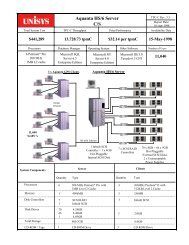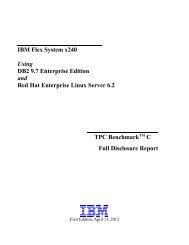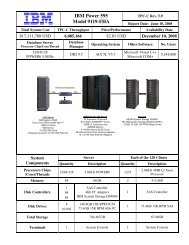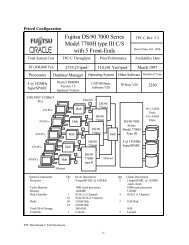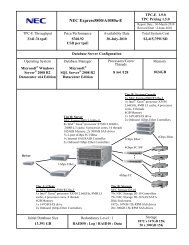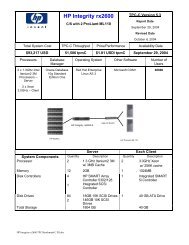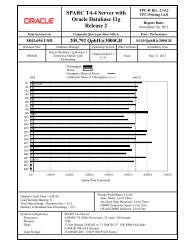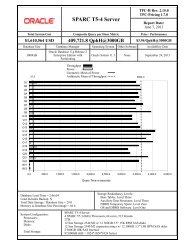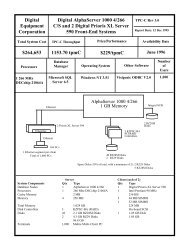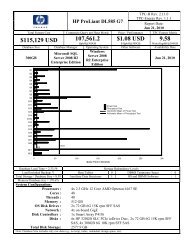Full Disclosure Report
Full Disclosure Report
Full Disclosure Report
Create successful ePaper yourself
Turn your PDF publications into a flip-book with our unique Google optimized e-Paper software.
The following steps were performed to verify the isolation of two update transactions after the first one is rolled<br />
back:<br />
1. An ACID Transaction T1 was started for a randomly selected O_KEY, L_KEY and DELTA. The ACID<br />
Transaction T1 was suspended prior to Rollback.<br />
2. Another ACID Transaction T2 was started using the same O_KEY and L_KEY used in step 1 and a<br />
randomly selected DELTA.<br />
3. T2 waited.<br />
4. T1 was allowed to ROLLBACK and T2 completed.<br />
5. It was verified that T2.L_EXTENDEDPRICE = T1.L_EXTENDEDPRICE.<br />
3.3.5 Isolation Test 5 – Concurrent Read and Write Transactions on Different<br />
Tables<br />
Demonstrate the ability of read and write transactions affecting different database tables to make progress<br />
concurrently.<br />
The following steps were performed:<br />
1. An ACID Transaction T1 for a randomly selected O_KEY, L_KEY and DELTA. The ACID Transaction<br />
T1 was suspended prior to Commit.<br />
2. Another ACID Transaction T2 was started using random values for PS_PARTKEY and PS_SUPPKEY.<br />
3. T2 completed.<br />
4. T1 completed and the appropriate rows in the ORDER, LINEITEM and HISTORY tables were changed.<br />
3.3.6 Isolation Test 6 – Update Transactions During Continuous Read-Only Query<br />
Stream<br />
Demonstrate the continuous submission of arbitrary (read-only) queries against one or more tables of the database<br />
does not indefinitely delay update transactions affecting those tables from making progress.<br />
The following steps were performed:<br />
1. An ACID Transaction T1 was started, executing Q1 against the qualification database. The substitution<br />
parameter was chosen from the interval [0..2159] so that the query ran for a sufficient amount of time.<br />
2. Before T1 completed, an ACID Transaction T2 was started using randomly selected values of O_KEY,<br />
L_KEY and DELTA.<br />
3. T2 completed before T1 completed.<br />
4. It was verified that the appropriate rows in the ORDER, LINEITEM and HISTORY tables were changed.<br />
3.4 Durability Requirements<br />
The tested system must guarantee durability: the ability to preserve the effects of committed transactions and insure<br />
database consistency after recovery from any one of the failures listed in Clause 3.5.2.<br />
3.4.1 Permanent Unrecoverable Failure of Any Durable Medium<br />
Guarantee the database and committed updates are preserved across a permanent irrecoverable failure of any<br />
single durable medium containing TPC-H database tables or recovery log tables.<br />
The database log was stored on a RAID-1 protected array of two physical drives. The tables for the database were<br />
stored on 4 separate HP 60GB SSD SFF SATA disks. A backup of the database was taken.<br />
The tests were conducted on the qualification database. The steps performed are shown below:<br />
1. The complete database was backed up.<br />
2. 6 streams of ACID transactions were started. Each stream executed a minimum of 100 transactions.<br />
3. While the test was running, one of the disks from the database RAID-1 log was removed.<br />
4. After it was determined that the test would still run with the loss of a log disk, one 60GB SSD drive was<br />
removed.<br />
5. A checkpoint was issued to force a failure.<br />
HP TPC-H FULL DISCLOSURE REPORT 18 July, 2010<br />
© 2010 Hewlett-Packard Company. All rights reserved.



